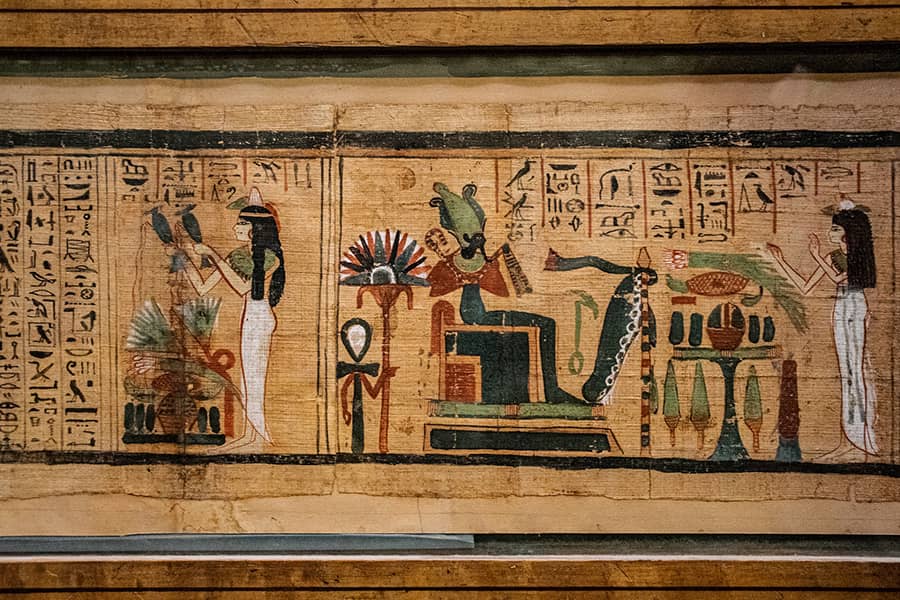Ancient Egypt: The Land of Pharaohs and Pyramids
April 11, 2023
Welcome to the fascinating world of Ancient Egypt, a civilization that flourished along the banks of the Nile River thousands of years ago. With its awe-inspiring pyramids, majestic temples, and intricate hieroglyphs, Ancient Egypt has captured the imaginations of people around the world for centuries. In this article, we will delve into the rich history, culture, achievements, and contributions of this ancient civilization that left an indelible mark on human history.
Table of Contents
History of Ancient Egypt
The history of Ancient Egypt dates back to over 5,000 years ago when the early civilization emerged along the fertile banks of the Nile River. The Nile was the lifeblood of Ancient Egypt, providing water, food, and transportation, which allowed the civilization to flourish. The ancient Egyptians developed sophisticated systems of irrigation, agriculture, and trade that helped them thrive in the harsh desert environment.
One of the most distinctive features of Ancient Egypt was its system of governance, ruled by pharaohs who were considered divine monarchs. The pharaohs were not only political leaders but also religious figures who were believed to be the intermediaries between the gods and the people. The pharaohs built grand temples, palaces, and monumental structures that reflected their power and authority.
The history of Ancient Egypt can be divided into three main periods known as the Old Kingdom, the Middle Kingdom, and the New Kingdom. During the Old Kingdom, which lasted from 2686 BCE to 2181 BCE, the pharaohs built the famous pyramids at Giza, including the Great Pyramid, which is one of the Seven Wonders of the Ancient World. The Middle Kingdom, from 2055 BCE to 1650 BCE, was marked by political stability, economic prosperity, and cultural achievements. The New Kingdom, from 1550 BCE to 1070 BCE, was considered the golden age of Ancient Egypt, characterized by military conquests, expansion of trade, and architectural marvels.
Culture and Society of Ancient Egypt
The culture and society of Ancient Egypt were deeply intertwined with religion, which played a central role in every aspect of daily life. The ancient Egyptians practiced a polytheistic religion, worshipping a pantheon of gods and goddesses who governed various aspects of nature, society, and human life. The pharaohs were believed to be the living gods on earth and were responsible for maintaining a harmonious relationship between the gods and the people.
The society of Ancient Egypt was highly hierarchical, with the pharaoh at the top of the social structure, followed by the nobility, priests, sapartans, scribes, artisans, and peasants. Slavery was also prevalent in Ancient Egypt, with slaves serving in various roles in society. The daily life of an average ancient Egyptian was centered around agriculture, with farming being the primary occupation. They also engaged in crafts, trade, and other economic activities.
The ancient Egyptians had a rich culture, with their unique art, music, dance, and literature. They were known for their elaborate ceremonies, festivals, and rituals, which were an integral part of their religious beliefs. The art of Ancient Egypt was highly symbolic and often depicted gods, pharaohs, and scenes from everyday life. One of the most iconic forms of ancient Egyptian art was hieroglyphs, a system of writing using pictorial symbols, which were used in inscriptions, monumental structures, and tombs.
Architecture and Engineering in Ancient Egypt
The architecture and engineering of Ancient Egypt were monumental and awe-inspiring, with the construction of grand structures that still stand today as a testament to their advanced skills and ingenuity. The most famous examples of ancient Egyptian architecture are the pyramids, massive structures built as tombs for the pharaohs and their families. The pyramids were constructed using limestone, granite, and other materials, and their construction involved precise engineering, mathematical calculations, and a massive workforce.
In addition to the pyramids, Ancient Egypt is also known for its magnificent temples and monuments. The temples were dedicated to various gods and goddesses and were considered the dwelling places of the gods on earth. The temples were adorned with intricate carvings, paintings, and statues, showcasing the artistic and architectural prowess of the ancient Egyptians. The Abu Simbel temples, Karnak Temple, and Luxor Temple are some of the most famous examples of ancient Egyptian temple architecture.
Another iconic structure of ancient Egyptian architecture is the Sphinx, a colossal statue with the body of a lion and the head of a human or animal. The Sphinx was believed to have protective powers and was often placed at the entrance of temples or other important structures. The construction of the Sphinx, like the pyramids, involved meticulous engineering and precise stone carving techniques.
Art and Literature in Ancient Egypt
The art and literature of Ancient Egypt were closely tied to their religious beliefs and daily life. The ancient Egyptians were skilled artists, known for their realistic and detailed sculptures, paintings, and jewelry. The art of Ancient Egypt was used to depict gods, pharaohs, scenes from daily life, and funerary rituals. The sculptures and paintings were often placed in temples, tombs, and other important structures, serving religious, ceremonial, and decorative purposes.
One of the most significant contributions of Ancient Egypt to world culture is the hieroglyphs, their system of writing using pictorial symbols. Hieroglyphs were used in inscriptions, monuments, and tombs, and were a crucial means of communication and record-keeping. The ancient Egyptians also produced a vast body of literature, including religious texts, poetry, historical accounts, and stories. Some of the most famous examples of ancient Egyptian literature are the Pyramid Texts, the Book of the Dead, and the Instructions of Amenemope.
Achievements and Contributions of Ancient Egypt
Ancient Egypt was a civilization of remarkable achievements and contributions that had a lasting impact on human history. In the field of medicine, the ancient Egyptians made significant advancements, developing surgical techniques, medicines, and medical instruments. They also had extensive knowledge of anatomy and were skilled in treating various ailments and injuries.
In mathematics, the ancient Egyptians developed a sophisticated system of counting and measurement. They used fractions, geometry, and algebra in various practical applications such as land measurement, construction, and trade. The ancient Egyptians also had a deep understanding of astronomy, using their knowledge to develop a calendar
system based on the movement of the stars and the flooding of the Nile River.
Another significant contribution of Ancient Egypt is its agricultural practices. The ancient Egyptians developed advanced irrigation systems, such as canals and reservoirs, to control the flooding of the Nile River and ensure fertile agricultural lands for farming. They also used innovative farming techniques, such as crop rotation and the use of animal manure as fertilizer, which contributed to their abundant food supply and economic prosperity.
In addition to their advancements in medicine, mathematics, and agriculture, the ancient Egyptians were also skilled in various crafts, such as metalworking, weaving, and pottery. They produced exquisite jewelry, textiles, and pottery, which were highly valued and traded with neighboring regions. The ancient Egyptians also had a well-organized system of trade, both within their kingdom and with other civilizations, which contributed to their wealth and prosperity.
Religion and Beliefs in Ancient Egypt
Religion played a central role in the daily life and culture of ancient Egyptians. They practiced a polytheistic religion, with a pantheon of gods and goddesses who were believed to have control over various aspects of life, such as the Nile River, fertility, and the afterlife. The pharaohs were considered as divine beings and were believed to be the intermediaries between the gods and the people.
The ancient Egyptians also believed in the concept of the afterlife, and the preservation of the body after death was of utmost importance to ensure a successful journey to the afterlife. This belief led to the practice of mummification, where the bodies of the deceased were carefully preserved with the use of herbs and resins, and placed in elaborate tombs with offerings of food, possessions, and prayers.
Women in Ancient Egypt
Women in Ancient Egypt had a unique status compared to other ancient civilizations. They had legal rights and could own and inherit property, engage in business, and participate in religious rituals. Women were also involved in various professions, such as priestesses, musicians, dancers, and scribes. However, their roles were often influenced by social norms and expectations, and their status varied depending on their social class and family background.
Women of the royal family, such as queens and princesses, had significant power and influence, often serving as advisors to the pharaohs and engaging in diplomatic activities. Some women in Ancient Egypt even held the title of pharaoh, such as Hatshepsut, who ruled as a female pharaoh and was known for her successful reign.
Decline and Legacy of Ancient Egypt
Despite its remarkable achievements, Ancient Egypt faced its decline in the Late Period (664-332 BCE) due to internal conflicts, invasions from foreign powers, and economic decline. The Persian and Greek conquests weakened the kingdom, and eventually, Ancient Egypt fell under the rule of the Romans in 30 BCE.
However, the legacy of Ancient Egypt continues to be felt today. Its art, architecture, literature, and advancements in various fields have left a lasting impact on human civilization. The pyramids, temples, and other monumental structures still stand as marvels of ancient engineering and attract tourists from around the world. The hieroglyphs, the system of writing developed by the ancient Egyptians, have helped archaeologists and historians decipher the mysteries of their civilization.
Conclusion
Ancient Egypt was a civilization of grandeur, complexity, and innovation. It was a land of pharaohs and pyramids, with remarkable achievements in various fields such as architecture, art, literature, medicine, mathematics, agriculture, and trade. The ancient Egyptians had a rich culture, with their religious beliefs, social structure, and daily life intricately intertwined. Despite its eventual decline, the legacy of Ancient Egypt continues to fascinate and inspire people worldwide.
See also: 5 Amazing Ancient Civilizations
Recent Posts
How Much Should You Save for Retirement After 50?
July 11, 2025
Best Personal Loans for Seniors with Fixed Income
July 10, 2025
What medicare Covers in 2025: A Complete Guide
July 09, 2025
SUBSCRIBE TO OUR NEWSLETTERS
Subscribe our newsletter for latest news, questions. Let's stay updated!






